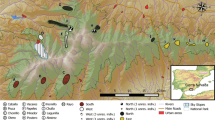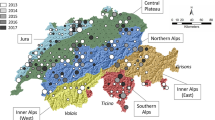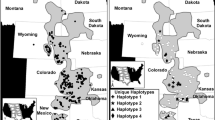Abstract
The Regal Fritillary butterfly, Speyeria idalia (Drury) (Lepidoptera: Nymphalidae), has been described as a high gene flow species. Supporting this assertion, previous studies in the Great Plains, where it is still relatively widespread, have found evidence of gene flow across hundreds of kilometers. Using mitochondrial and microsatellite loci, we examined the spatial genetic structure of a very isolated Pennsylvania population of these butterflies that occupies three separate meadows located within ten kilometers of each other. We found restricted gene flow and a distinct structure, with each meadow having a unique genetic signature. Our findings indicate that even a species that normally exhibits high gene flow may show fine-scale genetic subdivision in areas where populations have been largely extirpated.
Similar content being viewed by others

References
Barton B (1996) Final report on the regal fritillary 1992-1995. US Department of Defense, Annville, PA
Chazal AC (2002) Status Survey of the Regal Fritillary (Speyeria idalia) in 2002 on the Radford Army Ammunition Plant. Natural Heritage Technical Report 02-20. Virginia Department of Conservation and Recreation, Division of Natural Heritage, Richmond, VA
Dieringer D, Schlotterer C (2002) Microsatellite analyser (MSA): a platform independent analysis tool for large microsatellite data sets. Mol. Ecol. Notes 3:167-169
Fonseca DM, Campbell S, Crans WJ, Mogi M, Miyagi I, Toma T, Bullians M, Andreadis TG, Berry RL, Pagac B, Sardelis MR, Wilkerson RC (2001) Aedes (Finlaya) japonicus (Diptera: Culicidae), a newly recognized mosquito in the United States: analyses of genetic variation in the United States and putative source populations. J. Med. Entomol. 38:135-146
Frankham R, Ballou J, Briscoe D, McInnes KH (2004) A Primer of Conservation Genetics. Cambridge University Press, Cambridge, UK
Hammond PC (1991) Patterns of geographic variation and evolution in polytypic butterflies. J. Res. Lepidoptera 29:54-76
Hammond PC (1995) Conservation of biodiversity in native pairie communities in the United States. J. Kansas Entomol. Soc. 68:1-6
Hanski I (1998) Metapopulation dynamics. Nature 396:41-49
Keyghobadi N, Roland J, Strobeck C (1999) Influence of landscape on the population genetic structure of the alpine butterfly Parnassius smintheus (Papilionidae). Mol. Ecol. 8:1481-1495
Kopper BJ, Charlton RE, Margolies DC (2000) Oviposition site selection by the regal fritillary, Speyeria idalia, as affected by proximity of violet host plants. J. Insect Behav. 13:651-655
Layberry RA, Hall PW, LaFontaine JD (1998) The Butterflies of Canada. University of Toronto Press, Toronto
Opler PA, Krizek GO (1984) Butterflies East of the Great Plains. Johns Hopkins University Press, Baltimore
PA-NG (2002) Environmental Impact Statement, Enhanced Training and Operations at the National Guard Training Center at Fort Indiantown Gap: Volume II. Final Integrated Natural Resources Management Plan: Pennsylvania National Guard, 238 pp
Raymond M, Rousset F (1995) GENEPOP (version 1.2): population genetics software for exact tests and ecumenicism. J. Hered. 86:248-249
Ries L, Debinski DM (2001) Butterfly responses to habitat edges in the highly fragmented prairies of Central Iowa. J. Anim. Ecol. 70:840-852
Roland J, Keyghobadi N, Fownes S (2000) Alpine Parnassius butterfly dispersal: effects of landscape and populations size. Ecology 81:1642-1653
Rose OC, Brooks ML, Mallet JLB (1994) A quick and simple non-lethal method for extracting DNA from butterfly wings. Mol. Ecol. 3:275
Schneider S, Roessli D, Excoffier L (2000) Arlequin, version 2.000: a software for population genetics data analysis. 2.000 ed. Genetics and Biometry Laboratory, University of Geneva, Geneva, Switzerland
Thomas CD, Baguette M, Lewis OT (2000) Butterfly movement and conservation in patchy landscapes. In: Gosling LM, Sutherland WJ (eds), Behaviour and Conservation. Cambridge University Press, Cambridge, UK, pp. 85-104
van Oosterhout C, Hutchinson WF, Wills DPM, Shipley P (2004) Micro-Checker: software for identifying and correcting genotyping errors in microsatellite data. Mol. Ecol. Notes 4:535-538
VanDyck H, Matthysen E (1999) Habitat fragmentation and insect flight: a changing ‘design’ in a changing landscape?. Trends Ecol. Evol. 14:172-174
Williams BL (2002) Conservation genetics, extinction, and taxonomic status: a case history of the regal fritillary. Conserv. Biol. 16:148-157
Williams BL, Brawn JD, Paige KN (2002) Highly polymorphic loci for Speyeria idalia (Lepidoptera: Nymphalidae). Mol. Ecol. Notes 2:87-88
Williams BL, Brawn JD, Paige KN (2003) Landscape scale genetic effects of habitat fragmentation on a high gene flow species: Speyeria idalia (Nymphalidae). Mol. Ecol. 12:11-20
Acknowledgments
The authors are indebted to Joseph Hovis from the Pennsylvania Department of Military Affairs, Betty Ferster and Pat McElhenny of the Pennsylvania Chapter of the Nature Conservancy, as well as Greg Cowper, Amy Diercks, Tim Nightengale, Mark Swartz, and Andrea Widdel for help catching and handling specimens. We thank John Fronko, Donald Azuma and Thomas O’Donnell for administrative support. We thank Julie Smith, Michael Matrone, Tapan Ganguly and the DNA Sequencing Facility, University of Pennsylvania, for technical assistance. We also are indebted to two anonymous reviewers and Dr. Alfried Vogler for improving the final manuscript considerably. This project was initiated and sponsored by the PA Army National Guard, and funded by MIPR#3KCORPPH216 from the Department of Defense, as well as by a NSERC postdoctoral fellowship to NK. The content of this publication does not necessarily reflect the position or the policy of the United States Government, and no official endorsement should be inferred.
Author information
Authors and Affiliations
Corresponding author
Additional information
Authors contributed equally.
Rights and permissions
About this article
Cite this article
Keyghobadi, N., Unger, K.P., Weintraub, J.D. et al. Remnant populations of the regal fritillary (Speyeria idalia) in Pennsylvania: Local genetic structure in a high gene flow species. Conserv Genet 7, 309–313 (2006). https://doi.org/10.1007/s10592-006-9127-8
Received:
Accepted:
Published:
Issue Date:
DOI: https://doi.org/10.1007/s10592-006-9127-8



